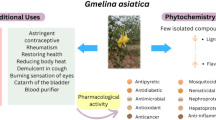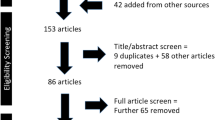Abstract
Purpose
To review the current literature on suspected green tea-related hepatic reactions and to describe two new cases reported within the framework of the Italian surveillance system of natural health products.
Results
A literature search of publication between 1999 and October 2008 retrieved 34 cases of hepatitis. Histological examination of the liver revealed inflammatory reactions, cholestasis, occasional steatosis, and necrosis. A positive dechallenge was reported in 29 cases. There was one reported death. A positive rechallenge occurred in seven cases (20%). In the two new cases, the causality assessment was judged as “possible” according to the RUCAM score.
Conclusions
Our analysis of the published case reports suggests a causal association between green tea and liver damage. The hepatotoxicity is probably due to (-)-epigallocatechin gallate or its metabolites which, under particular conditions related to the patient’s metabolism, can induce oxidative stress in the liver. In a few cases, toxicity related to concomitant medications could also be involved.
Similar content being viewed by others
References
Bruneton J (1999) Pharmacognosy, phytochemistry, medicinal plants, 2nd edn. Lavoisier Publ, Paris
Dufresne CJ, Farnworth ER (2001) A review of latest research findings on the health promotion properties of tea. J Nutr Biochem 12:404–421
Wolfram S (2007) Effects of green tea and EGCG on cardiovascular and metabolic health. J Am Coll Nutr 26:373S–388S
Shula Y (2007) Tea and cancer chemoprevention: a comprehensive review. Asian Pac J Cancer Prev 8:155–166
Kao YH, Chang HH, Lee MJ, Chen CL (2006) Tea, obesity, and diabetes. Mol Nutr Food Res 50:188–210
Menniti-Ippolito F, Mazzanti G, Santuccio C et al (2008) Surveillance of suspected adverse reactions to natural health products in Italy. Pharmacoepidemiol Drug Saf 17:626–635
Ben Yahia M, Mavier P, Metreau JM et al (1993) Chronic active hepatitis and cirrhosis induced by wild germander. Three cases. Gastroenterol Clin Biol 17:959–962
Castot A, Larrey D (1992) Hepatitis observed during a treatment with a drug or tea containing Wild Germander. Evaluation of 26 cases reported to the Regional Centers of Pharmacovigilance. Gastroenterol Clin Biol 16:916–922
Legoux JL, Maitre F, Labarriere D, Gargot D, Festin D, Causse X (1992) Cytolytic hepatitis and wild germander: a new case with reintroduction. Gastroenterol Clin Biol 16:813–815
Danan G, Benichou C (1993) Causality assessment of adverse reactions to drugs–I. A novel method based on the conclusions of international consensus meetings: application to drug-induced liver injuries. J Clin Epidemiol 46:1323–1330
Shim M, Saab S (2008) Severe hepatotoxicity due to Hydroxycut: a case report. Dig Dis Sci. doi:10.1007/s10620-008-0353-4
Bjornsson E, Olsson R (2007) Serious adverse liver reactions associated with herbal weight-loss supplements. J Hepatol 47:295–297 author reply 297-298
Federico A, Tiso A, Loguercio C (2007) A case of hepatotoxicity caused by green tea. Free Radic Biol Med 43:474
Molinari M, Watt KD, Kruszyna T et al (2006) Acute liver failure induced by green tea extracts: case report and review of the literature. Liver Transpl 12:1892–1895
Javaid A, Bonkovsky HL (2006) Hepatotoxicity due to extracts of Chinese green tea (Camellia sinensis): a growing concern. J Hepatol 45:334–335 author reply 335–336
Martinez-Sierra C, Rendon Unceta P, Martin Herrera L (2006) Acute hepatitis after green tea ingestion. Med Clin (Barc) 127:119
Jimemez-Saenz M, Martinez-Sanchez C (2006) Acute hepatitis associated with the use of green tea infusions. J Hepatol 44:616–617
Bonkovsky HL (2006) Hepatotoxicity associated with supplements containing Chinese green tea (Camellia sinensis). Ann Intern Med 144:68–71 Erratum in: Ann Intern Med 144:380
Mathieu N, Bouallegue L, Mognol P, Vallot T, Soule JC (2005) Hepatic toxicity probably due to X-elles used in phytotherapy. Gastroenterol Clin Biol 29:1188–1189
Gloro R, Hourmand-Ollivier I, Mosquet B et al (2005) Fulminant hepatitis during self-medication with hydroalcoholic extract of green tea. Eur J Gastroenterol Hepatol 17:1135–1137
Abu el Wafa Y, Benavente Fernandez A, Talavera Fabuel A, Perez Ramos MA, Ramos-Clemente JI (2005) Acute hepatitis induced by Camellia sinensis (green tea). An Med Interna 22:298
Stevens T, Qadri A, Zein NN (2005) Two patients with acute liver injury associated with use of the herbal weight-loss supplement hydroxycut. Ann Intern Med 142:477–478
Porcel JM, Beilsa S, Madroñero AB (2005) Hepatotoxicity associated with green tea extracts (electronic letters). Available online at http://www.annals.org/cgi/eletters/142/6/477#1669
Garcia-Moran S, Saez-Royuela F, Gento E, Lopez Morante A, Arias L (2004) Acute hepatitis associated with Camellia tea and Orthosiphon stamineus ingestion. Gastroenterol Hepatol 27:559–560
Lau G, Lo DS, Yao YJ, Leong HT, Chan CL, Chu SS (2004) A fatal case of hepatic failure possibly induced by nitrosofenfluramine: a case report. Med Sci Law 44:252–263
Dueñas Sadornil C, Fabregas Puigtio S, Durandez R (2004) Hepatotoxicity due to Camelia sinensis. Med Clin (Barc) 122:677–678
Peyrin-Biroulet L, Petitpain N, Kalt P et al (2004) Probable hepatoxicity from epigallocatecol gallate used for phytotherapy. Gastroenterol Clin Biol 28:404–406
Vial T, Bernard G, Lewden B, Dumortier J, Descotes J (2003) Acute hepatitis due to Exolise, a Camellia sinensis-derived drug. Gastroenterol Clin Biol 27:1166–1167
Pedros C, Cereza G, Garcia N, Laporte JR (2003) Liver toxicity of Camellia sinensis dried etanolic extract. Med Clin (Barc) 121:598–599
Bajaj J, Knox JF, Komorowski R, Saeian K (2003) The irony of herbal hepatitis: Ma-Huang-induced hepatotoxicity associated with compound heterozygosity for hereditary hemochromatosis. Dig Dis Sci 48:1925–1928
Kanda T, Yokosuka O, Tada M et al (2003a) N-nitroso-fenfluramine hepatotoxicity resembling chronic hepatitis. J Gastroenterol Hepatol 18:999–1000
Kanda T, Yokosuka O, Okada O, Suzuki Y, Saisho H (2003b) Severe hepatotoxicity associated with Chinese diet product ‘Onshidou-Genbi-Kounou’. J Gastroenterol Hepatol 18:354–355
Thiolet C, Mennecier D, Bredin C et al (2002) Acute cytolysis induced by Chinese tea. Gastroenterol Clin Biol 26:939–940
Seddik M, Lucidarme D, Creusy C, Filoche B (2001) Is Exolise hepatotoxic? Gastroenterol Clin Biol 25:834–835
Gavilan JC, Bermudez FJ, Salgado F, Pena D (1999) Phytotherapy and hepatitis. Rev Clin Esp 199:693–694
Aithal GP, Day CP (2007) Nonsteroidal anti-inflammatory drug-induced hepatotoxicity. Clin Liver Dis 11:563–575
Gomez-Lechon MJ, Ponsoda X, O’Connor E, Donato T, Jover R, Castell JV (2003) Diclofenac induces apoptosis in hepatocytes. Toxicol In Vitro 17:675–680
Larson AM (2007) Acetaminophen hepatotoxicity. Clin Liver Dis 11:525–548
Magnin G, de Meeus JB, Sarfati R, Chaouchi O, Paillat A (1996) Hepatic cytolysis caused by tocolytic treatment using micronized natural progesterone. Presse Med 25:102–105
Altintas E, Oguz D, Kacar S, Ozderin Y, Sezgin O, Zengin NI (2004) Dydrogesterone-induced hepatitis and autoimmune haemolytic anemia. Turk J Gastroenterol 15:49–52
Yuen YP, Lai CK, Poon WT, Ng SW, Chan AY, Mak TW (2007) Adulteration of over-the-counter slimming products with pharmaceutical analogue—an emerging threat. Hong Kong Med J 13:216–220
Bun SS, Bun H, Guédon D, Rosier C, Ollivier E (2006) Effect of green tea extracts on liver functions in Wistar rats. Food Chem Toxicol 44:1108–1113
Chow HH, Hakim IA, Vining DR et al (2006) Effects of repeated green tea catechin administration on human cytochrome P450 activity. Cancer Epidemiol Biomarkers Prev 15:2473–2476
Donovan JL, Chavin KD, Devane CL et al (2004) Green tea (Camellia sinensis) extract does not alter cytochrome P450 3A4 or 2D6 activity in healty volunteers. Drug Metab Dispos 32:906–908
Jimenez-Saenz M, Martinez-Sanchez C (2007) Green tea extracts and acute liver failure: the need for caution in their use and diagnostic assessment. Liver Transpl 13:1067
Goodin MG, Bray BJ, Rosengreen RJ (2006) Sex- and strain-dependent effects of epigallocatechin gallate (EGCG) and epicatechin gallate (ECG) in the mouse. Food Chem Toxicol 44:1496–1504
Nakagawa K, Okuda S, Miyazawa T (1997) Dose-dependent incorporation of tea catechins, (-)-epigallocatechin-3-gallate and (-)-epigallocatechin into human plasma. Biosci Biotechnol Biochem 61:1981–1985
Isbruker RA, Edwards JA, Wolz E, Davidovich A, Bausch J (2006) Safety studies on epigallocatechin gallate (EGCG) preparations. Part 2: dermal, acute and short-term toxicity studies. Food Chem Toxicol 44:636–650
Chow HH, Hakim IA, Vining DR et al (2005) Effects of dosing condition on the oral bioavailability of green tea catechins after single-dose administration of Polyphenon E in healthy individuals. Clin Cancer Res 11:4627–4633
Ullmann U, Haller J, Decourt JP et al (2003) A single ascending dose study of epigallocatechin gallate in healthy volunteers. J Int Med Res 31:88–101
Lambert JD, Lee MJ, Lu H et al (2003) Epigallocatechin-3-gallate is absorbed but extensively glucuronidated following oral administration to mice. J Nutr 133:4172–4177
Takami S, Imai T, Hasumura M, Cho YM, Onose J, Hirose M (2008) Evaluation of toxicity of green tea catechins with 90-day dietary administration to F344 rats. Food Chem Toxicol 46:2224–2229
Galati G, Lin A, Sultan AM, O’Brien PJ (2006) Cellular and in vivo hepatotoxicity caused by green tea phenolic acids and catechins. Free Radic Biol Med 40:570–580
Schmidt M, Schmitz HJ, Baumgart A et al (2005) Toxicity of green tea extracts and their constituents in rat hepatocytes in primary culture. Food Chem Toxicol 43:307–314
Sang S, Hou Z, Lambert JD, Yang CS (2005) Redox properties of tea polyphenols and related biological activities. Antioxid Redox Signal 7:1704–1714
Sang S, Lambert JD, Hong J et al (2005) Synthesis and structure identification of thiol conjugates of (-)-epigallocatechin gallate and their urinary levels in mice. Chem Res Toxicol 18:1762–1769
Lambert JD, Sang S, Yang CS (2007) Possible controversy over dietary polyphenols: benefits vs risks. Chem Res Toxicol 20:583–585
Author information
Authors and Affiliations
Corresponding author
Rights and permissions
About this article
Cite this article
Mazzanti, G., Menniti-Ippolito, F., Moro, P.A. et al. Hepatotoxicity from green tea: a review of the literature and two unpublished cases. Eur J Clin Pharmacol 65, 331–341 (2009). https://doi.org/10.1007/s00228-008-0610-7
Received:
Accepted:
Published:
Issue Date:
DOI: https://doi.org/10.1007/s00228-008-0610-7




